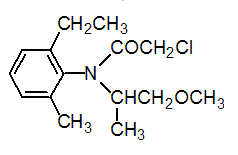METOLACHLOR 异丙甲草胺
Introduction: Metolachlor is a pre-emergence herbicide used to control certain weeds(broad-leaved and annual grassy weeds) in a variety of situations.
Common name: Metolachlor
Another name: Metholachlor, Pennant, Dual, Yibingjiacaoan, Codal, Dual Magnum, Dual Triple, Dual II, Ontrack 8E, Metelilachlor, Humextra, Metetilachlor, Jindual, Metoken, Pimagral, Bicel, etc.
Chemical name: 2-chloro-N-(6-ethyl-o-tolyl)-N-[(1RS)-2-methoxy-1-methylethyl]acetamide
Empirical formula: C15H22ClNO2
Structural formula:

Mol. Weight: 283.8 g/mol
CAS No.: 51218-45-2
Specifications
Leading Metolachlor supplier
Metolachlor 500 g/L EC
Metolachlor 720 g/L EC
Metolachlor 960 g/L EC
Metolachlor 96% TC
Packing:
BULK PACKING
Solid: 25kg/Bag, 25kg/Drum, 50kg/Drum etc.
Liquid: 200L/Drum, 20L/Drum, 10L/Drum ect.
SMALL PACKING
Solid: 1kg/Alu bag, 500g/Alu bag, 200g/Alu bag, 100g/Alu bag, 50g/Alu bag, 15g/Alu bag etc.
Liquid: 5L/Drum, 1L/Bottle, 500ml/Bottle, 250ml/Bottle, 100ml/Bottle, 50ml/Bottle etc.
Customerized packing label
Metolachlor FAO standard
Professional registration
HAZARDS IDENTIFICATION
Hazard statement(s)
H303: May be harmful if swallowed.
H317: May cause an allergic skin reaction.
H400: Very toxic to aquatic life.
H410: Very toxic to aquatic life with long lasting effects.
Precautionary statement(s)
P261: Avoid breathing dust/fume/gas/mist/vapors/spray.
P272: Contaminated work clothing should not be allowed out of the workplace.
P273: Avoid release to the environment.
P280: Wear protective gloves/protective clothing/eye protection/face protection.
P302+P352: IF ON SKIN: wash with plenty of water.
P312: Call a POISON CENTER or doctor/... if you feel unwell.
P321: Specific treatment (see ... on this label).
P333+P313: IF SKIN irritation or rash occurs: Get medical advice/attention.
P363: Wash contaminated clothing before reuse.
P391: Collect spillage.
P501: Dispose of contents/container to ...
Supplemental Hazard Statements: none
MAMMALIAN TOXICOLOGY
Acute toxicity: 1) Acute oral LD50 for rat: 1200 a.i.mg/kg. 2) Acute dermal LD50 for rat: >5050 a.i.mg/kg. 3) Inhalation LC50 (4 h) for rat: 2.02 a.i.mg/L. 4) Mildly-irritating to skin (rabbits). 5) Mildly-irritating to eyes (rabbits). 6) May cause skin sensitisation (guinea pigs).
NOEL: (90 d) for rats is 300 mg/kg diet (c. 15 mg/kg daily), for mice is 100 mg/kg diet (c. 100 mg/kg daily), for dogs is 300 mg/kg diet (c. 9.7 mg/kg daily).
ADI: 0.1 mg/kg b.w./day
Classification:
Toxicity class WHO (a.i.): III (Slightly hazardous)
US EPA Classification (formulation): III (Caution - Slightly toxic)
EC Risk Classification: Xn - Harmful: R43; N - Dangerous for the environment: R50, R53
ECOTOXICOLOGY
Effect on birds: moderate toxicity to birds, acute LD50 for Mallard ducks is 2000 a.i.mg/kg. Effect on fish: moderate toxicity to fish, acute 96 hour LC50 for Rainbow trout is 3.9 a.i.mg/L. Effect on aquatic invertebrates: moderate toxicity to aquatic invertebrates, acute 48 hour EC50 for Daphnia magna is 23.5 a.i.mg/L. Effect on algae: low toxicity to algae, acute 72 hour EC50 for Pseudokirchneriella subcapitata is 57.1 a.i.mg/L. Effect on honeybees: low toxicity to honeybees, contact acute 48 hour LD50 is >110 a.i.μg/bee, oral acute 48 hour LD50 is 110 a.i.μg/bee. Effect on earthworms: moderate toxicity to earthworms, acute 14 day LC50 is 140 a.i.mg/kg.
ENVIRONMENTAL FATE
Metolachlor's production may result in its release to the environment through various waste streams; its use as a herbicide will result in its direct release to the environment. If released to air, a vapor pressure of 3.14×10-5 mm Hg at 25 deg C indicates metolachlor will exist in both the vapor and particulate phases in the atmosphere. Vapor-phase metolachlor will be degraded in the atmosphere by reaction with photochemically-produced hydroxyl radicals; the half-life for this reaction in air is estimated to be 7 hours. Particulate-phase metolachlor will be removed from the atmosphere by wet or dry deposition. Metolachlor is expected to be susceptible to direct photolysis by sunlight with reported half-lives of 8-22 days. If released to soil, metolachlor is expected to have very high to slight mobility based upon a Koc range of 22-2320. Volatilization from moist soil surfaces is not expected to be an important fate process based upon a Henry's Law constant of 9.0×10-9 atm-cu m/mole; however, volatilization has been shown to occur at elevated temperatures. Metolachlor was not biodegraded in contaminated soil after 160 days of incubation, indicating that biodegradation is not an importanat environmental fate process in soil. Some loss of metolachlor from soil surfaces will occur as a result of photolysis by sunlight. If released into water, metolachlor is expected to adsorb to suspended solids and sediment based upon the Koc range. The aquatic biodegradation half-lives for metolachlor under aerobic and anaerobic conditions are 47 and 78 days, respectively. Volatilization from water surfaces is not expected to be an important fate process based upon this compound's Henry's Law constant. The photolysis half-life of metolachlor in lake water under summer conditions was reported as 11 days; however humic substances retarded the photolysis rate. The estimated hydrolysis half-life of metolachlor in water is 210 days. Whole body BCFs of <1 and 69 suggest bioconcentration in aquatic organisms is low to moderate.
Usage: Herbicide reported by H. R. Gerber et al. (Proc. Br. Weed Control Conf., 12th, 1974, 2, 787). Introduced by Ciba-Geigy AG (now Syngenta AG) and first marketed in 1976. Patents: BE 800471; GB 1438311; GB 1438312. Manufacturers: Drexel; Sannong; Sharda; Sundat; Syngenta. Cell division inhibitor; more recent research suggests chloroacetamides may inhibit synthesis of very long chain fatty acids (J. Schmalfuss et al., Abstr. Meeting WSSA, Toronto, 40, 117-118, 2000; P. Böger, Abstr. III Int. Weed Control Congr., Brazil 2000). Maize tolerance of chloroacetamides is attributed to rapid detoxification by glutathione transferases.
Application: Selective herbicide, absorbed predominantly by the hypocotyls and shoots. Inhibits germination. Control of annual grasses and some broad-leaved weeds in maize, sorghum, cotton, sugar beet, fodder beet, sugar cane, potatoes, peanuts, soya beans, safflowers, sunflowers, various vegetables, fruit and nut trees, and woody ornamentals. Applied pre-emergence, pre-plant incorporated or early post-emergence at, 1.0-2.5 kg/ha. Often used in combination with broad-leaved herbicides, to extend the spectrum of activity. Well tolerated by most broad-leaved crops, maize, sorghum (safened with fluxofenim or oxabetrinil).
| 






